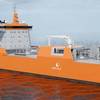Ocean Warming, Oxygen Loss Putting Marine Life Under Pressure
Alfred Wegener Institute conducts research in the Arctic, Antarctic and oceans of the high and mid-latitudes has pointed out that there exists few opportunities to change: Ocean warming and oxygen loss are putting marine life under more and more pressure
If you want to live, you need to breathe and muster enough energy to move, find nourishment and reproduce. This basic tenet is just as valid for us human beings as it is for the animals inhabiting our oceans. Unfortunately, most marine animals will find it harder to satisfy these criteria, which are vital to their survival, in the future. That was the key message of a new study recently published in the journal Science, in which American and German biologists defined the first universal principle on the combined effects of ocean warming and oxygen loss on the productivity of marine life forms. Their conclusion: as climate change progresses, these animals will be hard-pressed to satisfy their oxygen and energetic requirements in their changing native habitats. As a result, these species will migrate to cooler regions or deeper waters, ecosystems will be disrupted, and the diversity of species will decline.
In order to be able to make more precise and globally applicable prognoses concerning the effects of climate change on life in our oceans, marine biologists have long sought to find universal principles that would allow them to describe the living conditions in the oceans and at their borders. In this regard, one of the key questions is: How will the warming of the oceans and resultant decrease in dissolved oxygen impact marine life forms’ productivity? As marine biologist Prof Hans-Otto Pörtner from the Alfred Wegener Institute, Helmholtz Centre for Polar and Marine Science, who co-authored the article, explains, “If an animal has to do more work, it costs energy that it somehow has to produce over and above its resting metabolic rate. Marine life forms generate this additional energy by breathing and thereby taking up more oxygen. However, their ability to do so depends on two factors: the water temperature, and how sensitive the species is to lack of oxygen.”
In their new study, he and his American colleagues Curtis Deutsch, Brad Seibel, Aaron Ferrel and Raymond B. Huey calculated the ability of selected animal species to increase their metabolic rate, then examined that ability in relation with the temperatures and oxygen concentrations in the world’s oceans. This approach allowed them to create a metabolic index for each species, which sets clearly defined limits for oxygen-breathing sea life: “Marine animals like eelpouts, rock crabs and Atlantic cod can only survive in environments with enough oxygen for them to increase their metabolism to between two and five times their resting metabolic rate if need be. Every species has a certain maximum temperature to survive, and a certain minimum oxygen level, and the two requirements are related,” says lead author Curtis Deutsch from the University of Washington.
As such, the ongoing climate change poses the following problem for marine animals: the warmer the water gets, the less oxygen it can absorb and store. At the same time, in warmer water the animals will need more energy and oxygen to maintain their resting metabolic rate. This means the warmer the oceans become, the less able its inhabitants will be to boost their metabolism to between two and five times their resting metabolic rate, which is what allows them to move, seek food and reproduce. “If the oxygen level in a given region of the ocean drops below a species’ minimum requirements, it forces the animals to abandon their native habitat. This combines with the effect of warmer temperatures. Since animals evade to cooler regions, their habitat shifts towards the poles or to greater water depths. In Atlantic cod and many other fish species, we can already observe the shift now,” says Hans-Otto Pörtner.
In their study, the authors provide habitat-shift prognoses for all latitudes. As Hans-Otto Pörtner adds: “Further, the phenomenon is even more pronounced in those regions hit by additional oxygen loss, for instance due to increasing water stratification or because human beings release more nutrients into the ocean, promoting the growth of oxygen-stealing microorganisms.”
The researchers expect to see the most apparent changes in the polar seas. “The water in the Arctic and Antarctic Oceans is extremely cold, but also very rich in oxygen. Thanks to evolution, the animals living there have adapted to these conditions and will have little chance to adjust when the combination of warming and lower oxygen levels hits. Instead, species that immigrate from areas with higher water temperatures and lower oxygen concentrations will establish themselves and displace the native polar species,” says Hans-Otto Pörtner.
In the northern Pacific, for example, researchers are already observing a more extreme drop in oxygen concentrations than was expected due to warming alone. In this type of ocean region, the species’ geographic range is reduced drastically, which of course also means significant consequences for the fishing industry.
From a research perspective, the new metabolic index concept can potentially facilitate better prognoses. “We now have a universal approach that allows us to more precisely identify climate-related changes in the geographic range and productivity of a given species,” explains Hans-Otto Pörtner. Now it’s up to the scientific community to investigate the metabolic index and its limits for further species; if they do, Pörtner is confident that: “Bit by bit, we’ll arrive at a far more complete image of what we outlined in our study.”










